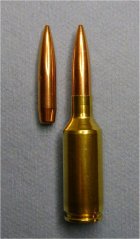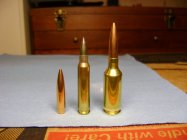I have just picked up my new 6.5x47 which works OK with the 130s, but with the 140s, the start of the boat tail sits just below (maybe .010") the neck/shoulder junction, with the bottom of the boat tail around the same level as the body/shoulder junction. I have only shot it over the crony while running in and so far the velocity and spread is OK.
Is there any ballistic problems with having the boat tail hanging down into the shoulder area? One of the 1000yd BR shooters here tells me , the boat tail in the shoulder area interferes with the ignition and ballistic efficiency, is there anything in that?
It has been my experience that if you keep the bearing surface (shank) above the neck / shoulder junction you will do fine. The "boattail" portion of the bullet will not be touching the brass case and will merely be "into the powder". I have had several rifles where "compressed" loads shot the best. It is when you have the bearing surface BELOW the neck / shoulder junction where problems CAN but not always arise..
1KBR said:
I have just picked up my new 6.5x47 which works OK with the 130s, but with the 140s, the start of the boat tail sits just below (maybe .010") the neck/shoulder junction, with the bottom of the boat tail around the same level as the body/shoulder junction. I have only shot it over the crony while running in and so far the velocity and spread is OK.
Is there any ballistic problems with having the boat tail hanging down into the shoulder area? One of the 1000yd BR shooters here tells me , the boat tail in the shoulder area interferes with the ignition and ballistic efficiency, is there anything in that???
Someone posted recently about spring loaded butts or recoil pads, this is something else I might look into. Don't know if they do anything more than a nice kickeze pad which mine wears though.
There is nothing to that... ignition is uniform regardless whether the end of the bullet protrudes below the neck/shoulder or not.
As to ballistic efficiency (whats that??).... it makes no difference - of course it will take up powder space, so velocities might be lower that expected, but it does not cause problems.
Google "cartridge case turbulence point" and decide for yourself.
I'd be willing to bet very few successful short range BR competitors used deep seated bullets as their winning formula.
IMHO it will most likely cause accuracy problems.
Isn't ballistic efficiency generally considered to be a powder charge that, as closely as possible uses all of it's energy inside the bore before the bullet emerges from the muzzle? The difference between modern cartridges and black powder comes to mind.
I only see two things that come into play with the Bullet seated below the junction. One is that you are past the donut. The second is that with the bullet seated that deep you lose powder capacity and will get pressure before maximum velocity. Matt
Don't know what your new 6.5x47's freebore is, but I've got a couple of 6.5x47 LR prone rifles that shoot Berger 140 LR BTs about as well as their 130VLDs out to 1000yds. I was trying to decide which of these two bullets to stick with a couple of years ago - shot several cleans on the MR-1 at 600 with both, but the X-count with the 130s was a little higher than with the 140s. There was so little difference between the two that I doubt you'll have any problem with either.
That was before they came out with the 140 Hybrid, which shoots very well in AICS mag length ammo for my 260 Imp 30*, even though they're seated considerably deeper in the case than the 140s are in the 6.5x47. I'm not saying the 140 Hybrids wouldn't shoot better if seated out farther, it's just not an option for mag length ammo. Since I shoot this rifle only in practical/tactical matches, single-loading longer rounds isn't really practical.
dkhunt14 said:
I only see two things that come into play with the Bullet seated below the junction. One is that you are past the donut. The second is that with the bullet seated that deep you lose powder capacity and will get pressure before maximum velocity. Matt
What donut? I use a Pilot/Reamer when I trim cases. If there was a donut there before, it's gone when I'm finished.
Sometimes one doesn't have a choice if the pressure ring is below the neck/shoulder junction. If you want to be able to shoot your rifle as a repeater the ammo has to fit the internal (or removable) magazine. When I've had to do that I haven't noticed any appreciable problems with loss of accuracy.
I don't like to use a reamer in my necks. It is inaccurate. I have good turned necks turned within a .0001 and don't want to change dimensions with a reamer. The only way you can control an inside reamers cut is if you have a die to keep the neck from moving. The guys at 1000 have found they get a lot more velocity and no pressure with longer freebores. That's why I like a .155 freebore for a Dasher. Matt
LHSmith said:
Google "cartridge case turbulence point" and decide for yourself.
I'd be willing to bet very few successful short range BR competitors used deep seated bullets as their winning formula.
IMHO it will most likely cause accuracy problems.
Actually turbulence point or something similar is something he mentioned. There is no donut in the necks and velocity is fine, so it is only a matter of whether a boat tail in the "turbulence point" will affect accuracy.
Edit. he just contacted me and said it was the "primer blast shock wave" which will be affected by having the boat tail hanging down so far.
I just googled it and here is a mention of it.
https://docs.google.com/viewer?a=v&q=cache:bFYJraWh_N4J:www.varminthunter.org/issuepdfs/Issue59.pdf+5mm/35+smc+cartridge+rifle+shooter&hl=en&gl=us&pid=bl&srcid=ADGEEShrP4RsIblNIZ5-UepmwRhYWyu_SBlAZgaBxRk2dcsOyoJiQjMju7I8YsJlkwNw1TiGi-v30sxnzYpm8ypRue0B2zIThWBhkvRVej_YguMqTMFJiR6fSuS0MiR_sw173IDuyDRs&sig=AHIEtbSvouyNxefjwM8H9DEF0tyuKlzbdg
I try to keep the pressure ring above the neck shoulder junction that way donuts don't become a problem because you're pressuring is above the donuts. JMHO JVON
Asked essentially the same question to Walt Berger a few years ago. He recommended that the bullet be seated so that the junction of the boat tail and the bearing surface remain in the sized portion of the case neck.
I have pretty much decided to get the barrel throated out slightly, the minimum necessary for the boat tail/shank area to clear the shoulder neck junction. It should only need .010-.030" to clear. This primer shockwave theory has me wondering though if it would best to throat it out another .060"-.080" instead to keep the boat tail out of that area. I don't need any extra powder volume as I have all the speed I need, just wondering about this primer shock wave thing?
dkhunt14 said:
I don't like to use a reamer in my necks. It is inaccurate. I have good turned necks turned within a .0001 and don't want to change dimensions with a reamer. The only way you can control an inside reamers cut is if you have a die to keep the neck from moving.
The "reamer" I'm using is not the traditional fluted reamer one thinks of when the word reamer comes up.
This is actually a pilot for an RCBS lathe type trimmer and only cuts the donut while the rest of the pilot/reamer body s in snug contact with the inside of the case neck. It does not cut laterally, it only cuts what sticks up at the case/neck junction. The results are as accurate as the inside of the case neck to begin with.
You know you don't want bullet bearing into donut area, as this can increase variance in bullet grip and MV.
I say 'can' because it depends on the cartridge & load. There has been a 30PUP (or something like that) described here that has no neck at all (just junction), but this is not a 6.5x47L, or a 7WSM, etc. It's a very limited condition of application, and with no advantage at all.
The primer shock-wave theory is a sales pitch for pure delusion. Same with neck turbulence points. Neither pass all tests.
Efficiencies seen in short-fat cartridge designs comes down to confinement and propelled mass as dynamic conditions. It's Gibb's front ignition stuff but with relative constriction instead of extended flash tubes. This applies most to overbore cartridges burning slower than normal powders (not a 6.5x47L). The more powder you can get to burn inside the chamber (instead of further down the bore), the lower the unburned powder mass added to bullet mass, burn % to length improves, and muzzle pressures drop.
But you will not adjust efficiency much in something like a 6PPC, where it's underbore and burning N133. The 6PPC case itself could be shaped any way you like with no further affect. This is where tests fail for broad claims in cartridge design.
Where some theories can be seen to pass tests is with something like a 26wssm (while disregarding wssm hype -please). It has a relatively wide but short powder column, good shoulder angle, low body taper, and the bore to chamber diameter ratio is high. This is adjusted for with 'weighting factor' in QuickLoad (a bottle-necking effect), and bumps efficiency and lowers muzzle pressures. Recoil is also lower than typical rules of thumb predict.
Anyway, here's mine shown with a baseline seating to touching, 139LAP, 35deg shoulders:
My accuracy load(mild) is at 3025fps, 28" barrel. I can reach ~3200fps before FL sizing is required. My ES with 20' Oehler screens is 8fps.
As you can see, I have a good amount of boat tail below junction, but my bearing is plenty safe.
-

26wssmSeatsm.jpg
113.3 KB
· Views: 180
For a sense of scale with this cartridge next to a 223:
-

26wssm_223compSM.jpg
46.2 KB
· Views: 92
I seat such that the 'pressure ring' on the bullet is above the neck/shoulder junction.
1KBR said:
I have just picked up my new 6.5x47 which works OK with the 130s, but with the 140s, the start of the boat tail sits just below (maybe .010") the neck/shoulder junction, with the bottom of the boat tail around the same level as the body/shoulder junction. I have only shot it over the crony while running in and so far the velocity and spread is OK.
Is there any ballistic problems with having the boat tail hanging down into the shoulder area? One of the 1000yd BR shooters here tells me , the boat tail in the shoulder area interferes with the ignition and ballistic efficiency, is there anything in that?
Have you considered extending the Lead or Freebore of your barrel's chamber? That will move the boattail forward of the neck/shoulder junction if you seat longer.

No, he'll always have some boat tail in the neck shoulder junction.
The 6.5x47L neck is ~.300" long and 26cal boat tail lengths are ~.200" long. Putting the end of these bullets short of neck/shoulder would only provide for ~.100" of grip on bullet bearing.
Given the length of these spears, that's short even for a radical like me, and I'm sure everyone seats them deeper.
He only needs to keep bearing out of the junction.












